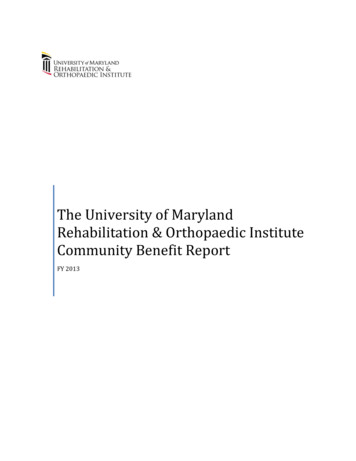
Transcription
Your Inpatient Rehabilitation Program in Shape?Current Compliance IssuesPresented by:Jane Snecinski, FACHEPrincipalNoblis Center for Health InnovationTracy M. Field, PartnerLife Sciences PracticeArnall Golden Gregory, LLPMark A. GuzaAttorney At LawArnall Golden Gregory, LLPHealth Care Compliance Association6500 Barrie Road, Suite 250, Minneapolis, MN 55435www.hcca-info.org 888-580-8373Agenda1. Hospital Rehabilitation Claims: Standards for Reimbursement Review of Standards Identifying Risk Areas: Are you a target? Voluntary Disclosure2. Managing an Adverse Outcome of Probe Audits, OIG, MAC or RAC Medical Necessity appeals Challenging Statistical Extrapolations to Defeat False Claims Act and FinancialLiability3. Practical Suggestions for Implementing a Successful Compliance Program Audit Focus Managing “red flags”4. Conclusion5. Questionswww.hcca-info.org888-580-837321
Inpatient Rehabilitation – Standards for Reimbursement Since 1/1/2002, inpatient rehabilitation has been under aProspective Payment System for reimbursement– Reimbursement based on the accurate assignment of the Case MixGroup (CMG) Impairment Category for admission to inpatient rehabilitation Functional status (as determined by the clinical staff) within the initialassessment period (first three days of admission) Age Co-morbidities– While only the CMG appears on the UB, all factors contributing to anaccurate assignment of the CMG must be accurate All claims for inpatient rehabilitation assume that the exemptinpatient rehabilitation unit/hospital meets the “75% Rule” and all ofthe “Conditions of tient Rehabilitation – Standards for Reimbursement Attestation (CMS form 437A) completed annually– 75% rule– Written admission criteria– Separate medical records, readily available for review– UR applicable standards– Beds physically separate– Unit staffed and ready first day of cost reporting period– Pre-admission screening process– Close medical supervision and furnish rehabilitation nursing, PT, OT,SLP, social services or Psychological services, P&O– POC– Coordinated, multidisciplinary team approach– Director of Rehabilitation (20 hours/40 hours) 75% Rulewww.hcca-info.org888-580-837342
Inpatient Rehabilitation – Standards for Reimbursement Conditions of Participation– The patient has to “require” an inpatient rehabilitation stay vs. any otherlevel of care– Intensity of rehabilitation (3 hours of therapy for a minimum of fivedays/week)– Rehabilitation nursingwww.hcca-info.org888-580-83735Inpatient Rehabilitation – Standards for Reimbursement Implications if standards are not met– Organization discovers Conduct an indepth analysis to determine extent of issues Determine cause Frequency of issues Length of time of issues– Example: 200 bed rural hospital 20 bed rehabilitation unit (ADC of 5 – 7) A staff member reported their concern to the compliance officer, who reportedto the FI. (Soon afterward another staff member reported the issue to the FI) Internal audit determined that nursing consistently coded two functional areasincorrectly on the initial PAI The extent of the “inaccurate” coding was estimated to be all patientsadmitted for a three year period Due to the inability to extrapolate to the entire population, the organizationnegotiated a payback of 275,000www.hcca-info.org888-580-837363
Inpatient Rehabilitation – Standards for Reimbursement– FI, MAC, RAC discovers The organization may have been paid inaccurately (by Medicare) and beexpected to “pay back” May conduct indepth audit to determine frequency and length of time Opens all recordsProvider status may be lost Potential (going forward) or actual reimbursement may be denied (and theorganization expected to “pay back”)– Example: RAC requests 60 records for review for medical necessity Determines that the medical necessity for the admission for all joint replacement andhip fracture was not demonstrated in the medical record. Denies payment retroactively for all joint replacement and hip fracture admissions forthe previous three years. The organization appealed all the denials; one year later the cases were justreaching the ALJ level The organization significantly decreased the admission of joint replacement and hipfracture on Services Medical Necessity– Is the service reasonable and necessary for diagnosis or treatment ofillness or injury or to improve the functioning of a malformed body part? Focus– Treatment– Settingwww.hcca-info.org888-580-837384
Medical Necessity Review“Standards” Local Coverage Determinations (LCDs) Local medical review Provider input critical –LCDs can be changed–MAC consolidationNational Coverage Determinations (NCDs)* Caveat: Standards are not the law!www.hcca-info.org888-580-83739Medical Necessity Reviewwww.hcca-info.org888-580-8373105
Medical Necessity ReviewInpatient Rehabilitation HCFA Ruling 85-2– Longstanding clinical reasoning/deference to physician judgment California LCD– LCD set precondition for hospitalization that SNF cannot provide care How to prove?www.hcca-info.org888-580-837311Medical Necessity ReviewOutpatient Rehabilitation ServicesCMS Transmittal 88 (May 7, 2008): Medicare Benefit Policy(Pub 1002) “Active Participation” by physician– No set time tables– No Form– Review of notes show physician involvement Therapy every other/every dayProgress in patient is “factor” in medical necessityDocumentation for records: can include correspondencewww.hcca-info.org888-580-8373126
Medical Necessity Reviewwww.hcca-info.org888-580-837313Medical Necessity Reviewwww.hcca-info.org888-580-8373147
Electronic Medical RecordsLegibility, but Other considerations “Cut and paste” Auto-population not always ideal Billing/coding prompts with documentation Customize t Rehabilitation – Standards for Reimbursement Medical necessity– The services provided must be realistic for the diagnosis identified There must be a documented reason for “skilled” therapy services– The patient has to be making (measureable) progress as a result of theservice provided Reaching “plateaus”The bill has to accurately reflect the services provided– Group vs. individual– Documented services reflect billed services Time Servicewww.hcca-info.org888-580-8373168
Outpatient Rehabilitation – Standards for Reimbursement Implications if standards are not met– Total or partial denial– If there are a significant number of questions, organization placed on“focused” review Example– A multi-system hospital had large outpatient therapy services at all fivehospitals in the system– Based on “internal concern”, the organization reported their concerns tothe FI– An indepth analysis revealed that inaccurate billing of individual therapyhad occurred when in fact group therapy was provided– While it was uncertain how long the inaccurate billing had taken place, apayback of 700,000 was made to the fiscal ying Risk Areas: Are you a target for review? Inpatient– The medical necessity for the admission is not supported in the medicalrecord The patient’s medical condition does not require admission to aninpatient/acute bed The patient does not need the intensity of an inpatient rehabilitationprogram– Admitting diagnosis not documented as being treated– Clinical staff have not scored the patient accurately using the functionalscoring methodology Scores are not supported in the medical record– Diagnosis/condition does not require the treatment by a licensed staffmember (skilled)www.hcca-info.org888-580-8373189
Are you a target for review - Outpatient A high number of units of service billed on the same day A high volume of the same diagnosis for patients treated at same facility Admitting/treating diagnosis does not:– Support services of treating therapist/units of services billed– Require the services of a skilled therapist Length of treatment exceeds that which would be ‘normally accepted’– Patient has not made any noted progress for billing period (plateau’ed) Once record is pulled:– Medical necessity is not documented– Plan of care not current– Progress made does not support number of treatments provided/billed– Physician’s script not current– Billed services not supported in documentationwww.hcca-info.org888-580-837319OIG FocusTherapy IssuesOIG has correlated various records to sear for inconsistencies, e.g.: Compared therapist time sheets with patient billing recordsOIG investigations of services that could have been rendered in a less intensivesetting have focused on: Uncomplicated knee, hip and other single joint replacements, and Simple orthopedic injuries and medical or neurological conditions thatrequired only general muscle strengthening and reconditioningwww.hcca-info.org888-580-83732010
Potential LiabilityFalse Claims Penalties - OIGA provider’s potential liability when it provides services that are laterfound to be medically unnecessary is enormous. False claims provisions of the Federal fraud and abuse statute provideliability for:– Submitting a claim that the person knows or should have know was falseor fraudulent; or– Submitting a claim for services that the person know or should haveknow were up-coded. CMP – up to 10,000.00 per claim. Assessment - up to 3 time s the amount claimed for each item or servicescovered by the claim(s) Exclusion from Federal health care programswww.hcca-info.org888-580-837321Potential LiabilityKnowledge of FalsityThe element of false claims liability that distinguishes it from routineoverpayments is the person or entity must have knowledge of the falsityof the claim But, willful ignorance of the situation will suffice for actualknowledge.www.hcca-info.org888-580-83732211
Potential LiabilityFederal False Claims Act DOJ Provides for civil and criminal penalties Authorizes private person (termed a “Relator”) to bring action underthe name of the government and share in recovery.www.hcca-info.org888-580-837323Voluntary Disclosure to OIGNature of the ProcessA procedure for resolving civil money penalty liability under Stark and theFederal fraud and abuse law. Not an amnesty program OIG will impose penalties General pledge of leniency but no up-front commitment–Usually OIG will not impose exclusion–OIG will generally settle for an amount near the lower end of thepossible range of CMP liability–Generally the less costly and onerous Certification of ComplianceAgreement is imposed instead of a Corporate Integrity Agreementwww.hcca-info.org888-580-83732412
Voluntary DisclosurePending InvestigationIf the claims are already subject of an investigation the OIG will notaccept a provider’s request for treatment under the Self DisclosureProtocol, e.g. RAC has already requested medial records Relator has filed suite and initialed government inquiry.www.hcca-info.org888-580-837325Voluntary DisclosureInitial SubmissionThe Initial submission to OIG must contain detailed information about thematter and the names of those involved, those who knew or should haveknown of the situation and those who detected and investigated the situation.The submission should include: A complete description of the conduct being disclosed;–Be as specific as possible to prevent any later audit by RAC from beingconsidered outside scope of voluntary disclosure A description of the provider’s internal investigation or a commitment whenit will be completed (within 3 months); An estimate of the damages to the Federal health care programs and themethodology used to calculate the figure; A statement of the laws potentially violated by the conductwww.hcca-info.org888-580-83732613
Voluntary DisclosureCooperation with OIG InvestigationOIG performs its own investigation to verify information submitted byProvider. OIG insists on full cooperation from the provider during its verificationprocess (production of documents and interviews with employees)www.hcca-info.org888-580-837327Voluntary DisclosureDecision to Voluntarily DiscloseVoluntary disclosure program is not appropriate for mere billing errors oroverpayments. Disclosures of these matter should be submitted directly to theappropriate Medicare claims processing entityVoluntary disclosure is intended for situations that involve fraud: examples of situations that may involve fraud:– Systematic upcoding;– Falsified recordsProvider should conduct a thorough internal investigation before disclosingso that the decision to disclose is based on complete knowledge of thenature and extent of the problem.www.hcca-info.org888-580-83732814
Voluntary DisclosureDecision to Disclose – Additional Concerns DoJ is not bound by OIG’s resolution of the Matter Voluntary disclosure entails providing substantial evidence to theGovernment which could prejudice the defense of later lawsuits aling A DenialDenial (“Initial Determination”)RedeterminationQualified Independent Contractor (QIC)Administrative Law Judge (ALJ)Medicare Appeals Council (MAC/[Departmental Appeals Board (DAB)]Federal CourtNote:After redetermination, can escalate to next level ifreviewing entity fails to meet deadlines (60d) to decide casewww.hcca-info.org888-580-83733015
Appealing A DenialRequest for Redetermination Reviewer informs you of denial– Must give specific reason for denial File with Fiscal Intermediary/MAC– 120 days to file, but recoupments start earlier– CMS form v. g A Denialwww.hcca-info.org888-580-83733216
Appealing A DenialPractical Considerations in Filing Redetermination Requests Space limitations on CMS forms Preference: Provider letterhead Ability to highlight stay of recoupment : Be sure to copy MAC/FI onappeals requestswww.hcca-info.org888-580-837333Recoupment Medicare Modernization Act of 2003 CMS Transmittal 322– Issued March 5, 2008– Effective July 1, 2008– Recoupment 40 days from determination date “should beautomated”– Stays only through first 2 levels of appeal– Interest accrues while appeal is pendingwww.hcca-info.org888-580-83733417
Stay of RecoupmentAnMed et al v. Leavitt / Case No. 8:08-2453-HFF Filed July 3, 2008, U.S. District Court, S.C. Complaint for Declaratory Judgment, Injunction and Mandamus 32 Providers sued, asserting recoupment while appeals processpending violated § 935(a) of the Medicare Modernization Act of2003 (MMA)- Recoupment by RACs almost immediately- Stay tuned www.hcca-info.org888-580-837335Appeals ProceduresPractical Considerations Benefits to early filing– If technical defect, may refile– Stay in recoupment Reserve right to supplement To ensure stay in recoupment, communicate with FI/MACwww.hcca-info.org888-580-83733618
Appeals ProceduresRedetermination Decision Must decide in 60 days– Cannot escalate if FI is late If favorable, no letter!– Tracking is critical* Providers are winning at this levelwww.hcca-info.org888-580-837337Appeals ProceduresReconsiderations Conducted by Qualified Independent Contractors (QIC)–Panel of physicians or other “appropriate health professionals”–Use “clinical experience, and medical, technical and scientific evidence” On-the-Record review (!)*Submit all evidence to be consideredwww.hcca-info.org888-580-83733819
Appeals Procedureswww.hcca-info.org888-580-837339Appeals ProceduresReconsideration Decisions Informed of Decision in 60 days–Decision issued in all cases: fully favorable as well as for full or partialdenials–Specific reason for denials– Can escalate if decision not timely issued– Notice given if fully, partially or unfavorableOnly 60 days to file at next level – before the Administrative LawJudgewww.hcca-info.org888-580-83734020
Appeals ProceduresAdministrative Law Judges With new appeals process, HHS needed ALJs familiar with Medicare– Clinical progress notes closely scrutinized ALJ “Hearings”– On the record– Telephonic– In person– No New evidence submitted, absent “good cause” Note: Some ALJs relatively “new” to Medicare, so important toinclude legal standards for reimbursement in appeals.www.hcca-info.org888-580-837341Appeals ProceduresStatistical Review Reviewer requests 20 records for period– Error rate based on review of 20 records– Extrapolation to entire universe– “Small” audits can have major consequences Monetary recoupment False Claims Act?Tip: Consider Escalation?www.hcca-info.org888-580-83734221
Voluntary Disclosure to OIGNature of the ProcessA procedure for resolving civil money penalty liability under Stark and theAnti-Kickback Statute Not an amnesty program OIG will impose penalties General pledge of leniency but no up-front commitment– Usually OIG will not impose exclusion– OIG will general y settle for an amount near the lower end of thepossible range of CMP liability– Generally the less costly and onerous a Certification of ComplianceAgreement is imposed instead of a Corporate Integrity Agreementwww.hcca-info.org888-580-837343Voluntary DisclosureInitial SubmissionThe Initial submission to OIG must contain detailed information about thematter and the names of those involved, those who knew or should haveknown of the situation and those who detected and investigated the situation.The submission should include: A complete description of the conduct being disclosed; A description of the provider’s internal investigation or a commitment whenit will be completed (within 3 months); An estimate of the damages to the Federal health care programs and themethodology used to calculate the figure; A statement of the laws potentially violated by the conductwww.hcca-info.org888-580-83734422
Voluntary DisclosureCooperation with OIG InvestigationOIG performs its own investigation to verify information submitted byProvider. OIG insists on full cooperation from the provider during its verificationprocess (production of documents and interviews with employees)www.hcca-info.org888-580-837345Voluntary DisclosureDecision to Voluntarily DiscloseVoluntary disclosure program is not appropriate for mere billing errors oroverpayments. Disclosures of these matter should be submitted directly to theappropriate Medicare claims processing entityVoluntary disclosure is intended for situations that involve fraud: examples of situations that may involve fraud:– Systematic upcoding;– Falsified recordsProvider should conduct a thorough internal investigation before disclosingso that the decision to disclose is based on complete knowledge of thenature and extent of the problem.www.hcca-info.org888-580-83734623
Voluntary DisclosureDecision to Disclose – Additional Concerns DoJ is not bound by OIG’s resolution of the Matter Voluntary disclosure entails providing substantial evidence to theGovernment which could prejudice the defense of later lawsuits tical Suggestions for Implementing a SuccessfulCompliance ProgramInternal Controls can effectively detect,lessen or eliminatepotential compliance failureswww.hcca-info.org888-580-83734824
Audit Focus Consider issues that are important to the compliance ofrehabilitation and not issues that are important to a general hospital Inpatient rehabilitation–75% Rule –Medical necessity Treatment of admitting diagnosisMedical need to be admitted to an acute care bed plus a necessity for anintensive inpatient rehabilitation program–Accurate scoring on the PAI–Conditions of participationOutpatient rehabilitation– The necessity for skilled services– The necessity for services related to the admitting/treating diagnosis– Billed services correlate with documented services– Billed services reflect treatment providedwww.hcca-info.org888-580-837349Managing Red Flags Education and training for staff– Creating staff knowledge base of their responsibilities related to demonstration ofcomplianceInpatient––“Mentoring” of new staff, agency, prn staff Functional scoring training (competence vs. certified) Rehab vs. med/surg nursingInterdisciplinary communication Discussion among the treatment team about the reason the patient is admitted toinpatient rehabilitation and the diagnoses that will be “treated”–Correlate the nursing care hours/per patient day and the case weight of thepatient population–Ensuring therapy coverage (including weekends) to provide an intensiverehabilitation program?–Ability of EMR to reflect “inpatient rehabilitation program” and “medical necessity”www.hcca-info.org888-580-83735025
Managing Red Flags Outpatient– Therapy expectations need to support the accurate provision/billing ofoutpatient treatment– Scheduling of patients should support accurate provision/billing ofoutpatient treatment– Review of diagnosis (upon admission) to support treatment and plan ofcare– Processes should allow for review of billed charges/date of servicewww.hcca-info.org888-580-837351Managing Red FlagsKnow when to involve counselwww.hcca-info.org888-580-83735226
References Code of Federal Regulations, 42 – CFR Ch. IV, 412.23, 412,25 and 412.29 Federal Register, Part II, Department of Health and Human Services, 42CFR Part 412, “Medicare Program: Inpatient Rehabilitation FacilityProspective Payment System for FY 2006; Final Rule” Medicare Benefit Policy Manual, Chapter 1 – Inpatient Hospital ServicesCovered Under Part A, “110 – Inpatient Hospital Stays for RehabilitationCare” Appeal of Claims 42 C.F.R. § 405.900 et seq.www.hcca-info.org888-580-837353Contact InformationTracy M. FieldPartnerArnall Golden Gregory, LLP171 17th Street NWSuite 2100Atlanta, GA 30363www.agg.comJane Snecinski, FACHEPrincipalCenter for Health Innovation6525 The Corners ParkwaySuite 450Norcross, GA 1.4422Mark A. GuzaAttorney at LawArnall Golden Gregory, LLP171 17th Street NWSuite 2100Atlanta, GA .87965427
All claims for inpatient rehabilitation assume that the exempt inpatient rehabilitation unit/hospital meets the "75% Rule" and all of the "Conditions of Participation" 4 www.hcca-info.org 888-580-8373 Inpatient Rehabilitation - Standards for Reimbursement Attestation (CMS form 437A) completed annually - 75% rule










